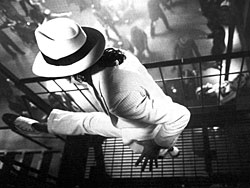 |
The recent death of pop icon Michael Jackson has generated many tributes to his life and work, but perhaps the most honest and probing of these is a piece of work he created when he was still alive. Coming out in 1988 when Michael Jackson was at the height of his career (or soon after it), when his enormous celebrity became ungainly and uncomfortable, Moonwalker is a bizarre and yet fitting memorial to Michael Jackson, a kind of video scrapbook melding into a dream journal.
His seventh solo album Bad had come out recently and was spawning a bevy of now-easily recognizable hits. That year, when he packed stadiums on his world tours, was easily a period of his ascendancy as an international sensation. But it was also the first time his eccentricities were aggressively coming to fore, doggedly reported by the tabloids, from his seeming addiction to cosmetic surgery to his odd purchases, including a Chimp he named Bubbles.
Moonwalker, in its meandering self-indulgent way, concerns these two major themes of Michael Jackson's career: his incredible success as a commercial artist (with a hagiographic self-regard) and the struggle to negotiate his celebrity and image (with admonitions to the media along with some comfortable self-mocking).
The tagline of Moonwalker is "From the imagination of Michael Jackson comes a movie like no other," a rousing marketing statement that is accurate but makes no specific claims about the film's contents. And it is easy to understand why. Directed by Jerry Kramer, it is an assemblage of a few past music videos with its last, 'Smooth Criminal', lengthened into a bizarre, nonsensical, and now perhaps controversial, mini-movie involving Michael Jackson keeping the world safe for kids. He is shown transforming into various machines - a car, a robot and, yes, even a spaceship?and killing or running away from gangsters. In videos that show his skin turning liquid and his face and body morphing, one catches a theme that resurfaces in his later videos, from 'Black or White' and 'Remember the Time', and, earlier, the superb 'Thriller,' where he changes into a werewolf.
Moonwalker doesn't hold coherently but it is fun. This is not surprising, as Jackson has undoubtedly been responsible for some of the most memorable music videos in history. There is a delightful parody of his Martin Scorsese-directed 'Bad' video with Michael Jackson and his crew of dancers replaced with cute and uncannily similar children-doppelgangers, running around in a frame-by-frame, move-by-move imitation of that rampage through the subway station.
Even though music television stations today give less play to music videos, their short length, the premium on keeping your attention and their viral addictiveness anticipates the youtube generation. Of course, the transition from the small screen to the even smaller screen shifts many of the rules of the arts but still one is struck by how current these videos seem. For instance, Jackson's 'Man in the Mirror', which opens Moonwalker with footage of his concerts interspersed with clips of Gandhi, Mandela, King and Kennedy, could easily have been made by a devout fan today. The lo-fi but detailed and effective video animated with deft virtuosity by Jim Blashfield in 'Leave Me Alone' anticipates the striking ingenuity of video artists who have carved out little followings of their own on the internet.
Jim Blashfield, who seems to have single-handedly defined the American pop music videos of the 80s with his oeuvre of idiosyncratic and absurd animations tapping uncomfortably into the subconscious, captures the conflicted relationship the Jackson had with his public in his 'Leave Me Alone.' In a satirical rollercoaster ride in what could be Jackson's famous Neverland Ranch, Blashfield explodes the tabloid headlines that plagued his subject. Blashfield somehow champions Jackson, even as he manages to probe his complicated psyche.
Moonwalker opens with the video to 'Man in the Mirror,' a kind of Gandhian exhortation to be the change you want to see in the world. It is a kind of song that becomes a staple of his songbook, political platitudes converted into stirring anthems.
But the video is also remarkable for the scenes of legions of his fans at his concerts, delirious and ecstatic, a testament to his power and draw as an icon. And icon is the appropriate word for this strange, stylish, talented man-child, part-Fred Astaire, part-Pee Wee Herman, whose cult-like and devoted fan-base would put megachurches to shame in their size and extravagance. MJ might be held to ridicule (and even this critic can't seem to withhold a few potshots), but in our global pop culture, he is a giant that divides everything that comes before him from everything that comes after.



